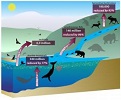Declines in Marine, Large Animals Disrupt Earth’s Nutrient Cycle

A new study reveals that in the past large land animals, whales, seabirds and fish played a vital role in recycling nutrients from the ocean depths, spreading them far and wide across the globe and taking them deep inland. However, the paper says massive declines in their populations coupled with the extinction of most of Earth’s large mammals have disrupted this efficient system of recycling important nutrients, particularly phosphorous. The researchers calculate that the ability of whales and terrestrial megafauna to transport nutrients around the globe has been reduced to just 6% of their global capacity before mass extinctions and population declines. The full paper is published in the journal, Proceedings of the National Academy of Sciences.
The paper led by the University of Oxford, with researchers from the United States and other European institutions, explains that some whales and other marine mammals feed in nutrient-rich waters at depths of around 100 metres and come to the sea’s surface to defecate and urinate, releasing vital nutrients like phosphorous. The researchers used existing data, showing global declines in whale populations of 66% — 90% within the past 300 years, to compare the ability of the whales to distribute nutrients both historically and today. Previously, whales and other marine mammals moved a global total of around 340 million kg of phosphorous a year from the depths to the water surface, but now transport just 75 million kg of phosphorous (about 23% of their former capacity). They used data on past seabirds and anadromous fish populations (that swim in both the sea and rivers) that feed in the ocean and later release the nutrients on land when they defecate or their bodies decompose. The researchers calculate that in the past, seabirds and fish populations could have transferred around 150 million kg of phosphorous a year from sea to land. They estimate that fish played the major part, transporting around 140 million kg a year on average compared with seabirds that averaged at 6.3 million kg a year. This sea to land transfer of nutrients has declined by more than 90% today, says the paper.
Source:
http://www.enn.com/wildlife/article/49110

